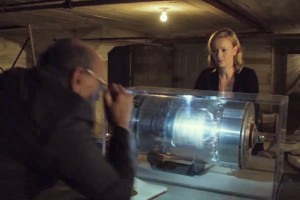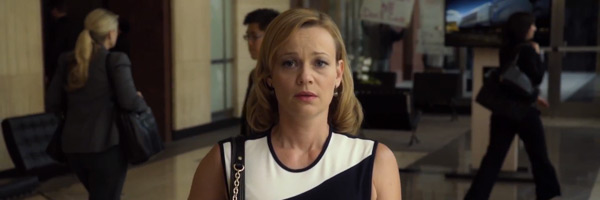 Greetings fans of Ayn Rand and prepare for the second installment of the 3-part Atlas Shrugged. Production details have been kept pretty much under wraps, but we finally have a trailer! About time, too — it’s coming to theaters October 12th. That’s the problem with low-budget independent films: less advertisement and press releases. But Reel Movie Nation’s here with the trailer, and the scoop.
Greetings fans of Ayn Rand and prepare for the second installment of the 3-part Atlas Shrugged. Production details have been kept pretty much under wraps, but we finally have a trailer! About time, too — it’s coming to theaters October 12th. That’s the problem with low-budget independent films: less advertisement and press releases. But Reel Movie Nation’s here with the trailer, and the scoop.
Plot Summary
Atlas Shrugged is a pre-apocalyptic drama featuring female railroad executive Dagny Taggart (Samantha Mathis) who is attempting to keep her business afloat in a fractured society. Worse than the destructive ”for the public’s good” regulations is the fact that all other competent workers — ore miners, motor companies, car manufacturers — are disappearing. Dagny must uncover the mystery of the disappearances, fight muddled politics, and make the world a place worth living.
Part 1
Part 1 was in theaters April 15, 2011. (Missed it? You’re not the only one, it only came out in a select few theaters — Netflix it!) In it, we get some background info and an introduction of all the main players We meet Hank Rearden, a steel tycoon with a distant and unappreciative family. We meet playboy and former love interest Francisco D’Anconia, who was once a great man but who now seems to be in a downward spiral of degradation. There’s James Taggart, Dagny’s incompetent brother and president of Taggart Transcontinental, the family railroad. There’s a whole slew of incompetent politicians and business owners, and a handful of shining stars — namely Ellis Wyat, an oil mogul.
Throughout Part 1 we see these stars disappear, always accompanied by that slang question nobody seems to know the origin or meaning of: “Who is John Galt?”
Part 2
I n Part 2, the fight continues. Politics are getting more and more restricting. The country is failing and anything Dagny or any of the competent few left do to prolong its doom is denounced as immoral, or greedy, or self-serving. A society that turned corrupt for “the common good” is now turning violent. However, there’s a glimmer of hope — an incomplete motor found in an abandoned factory, a motor that would change the world. Now Dagny’s trying to find the maker of the motor, or someone, anyone, intelligent enough to repair it. There’s also still the question of where all the successful “movers” of the world have gone, and a search to find the answer to the question, “Who is John Galt?”
n Part 2, the fight continues. Politics are getting more and more restricting. The country is failing and anything Dagny or any of the competent few left do to prolong its doom is denounced as immoral, or greedy, or self-serving. A society that turned corrupt for “the common good” is now turning violent. However, there’s a glimmer of hope — an incomplete motor found in an abandoned factory, a motor that would change the world. Now Dagny’s trying to find the maker of the motor, or someone, anyone, intelligent enough to repair it. There’s also still the question of where all the successful “movers” of the world have gone, and a search to find the answer to the question, “Who is John Galt?”
Between Part 1 and Part 2, there has been an almost complete cast makeover. Samantha Mathis replaced Taylor Schilling as Dagny Taggart, Jason Beghe replaced Grant Bowler as Hank Rearden, Esai Morales replaced Jsu Garcia as Francisco D’Anconia, Patrick Fabian replaced Mathew Marsden as James Taggart, and many more. New director too — now we’ve got John Putch directing instead of Paul Johansson. Basically it’s been an entire re-boot of staff and cast. Why? Nobody’s saying. There have been complaints that the dialogue sounded stilted, though that’s probably not the actor’s fault and more the result of trying to translate a futuristic movie too directly from a 1950s novel. Whatever the reason, the vision’s not being set back by new cast and crew.
The Philosophy
![20120831-135602[1]](https://reelmovienation.com/wp-content/uploads/2012/09/20120831-1356021.jpg) Even if you don’t know much else about Ayn Rand or her novel, you’ve probably heard it’s controversial. When Atlas Shrugged was first published, it got dismissed by many as “an homage to greed.” Opposers find its anti-charity, pro-capitalism message harsh.
Even if you don’t know much else about Ayn Rand or her novel, you’ve probably heard it’s controversial. When Atlas Shrugged was first published, it got dismissed by many as “an homage to greed.” Opposers find its anti-charity, pro-capitalism message harsh.
Basically, her idea is that an altruistic society will fail. If everyone always looks after their neighbors instead of themselves and looks after their neighbor’s children before their own, the world would starve. Instead of living by your own ability, you would find yourself reliant on everyone else’s. You would find yourself in a society where it’s the needy who are rewarded, not the able. In her book, there’s a line that sums it up well: “From each according to his ability, to each according to his need.” That quote is how the society in Atlas Shrugged is functioning. Only the ones with ability are disappearing, leaving a world full of insatiable need.
If you’re interested in her philosophy, she expands on it (with contributions from philosopher Nathaniel Branden) in a collection of essays called The Virtue of Selfishness.
However, the first movie toned down the philosophy a lot, and it’s possible the second installation will do the same. So even if you’re not a fan of the overall message Rand’s trying to get at, you should still be able to enjoy the show.
Trailers
Here are the trailers for Part 1 (in case you missed it) and Part 2. What do you think? Will it be worth a drive to see, if it won’t be playing in your hometown? Let us know your thoughts in the comments!

